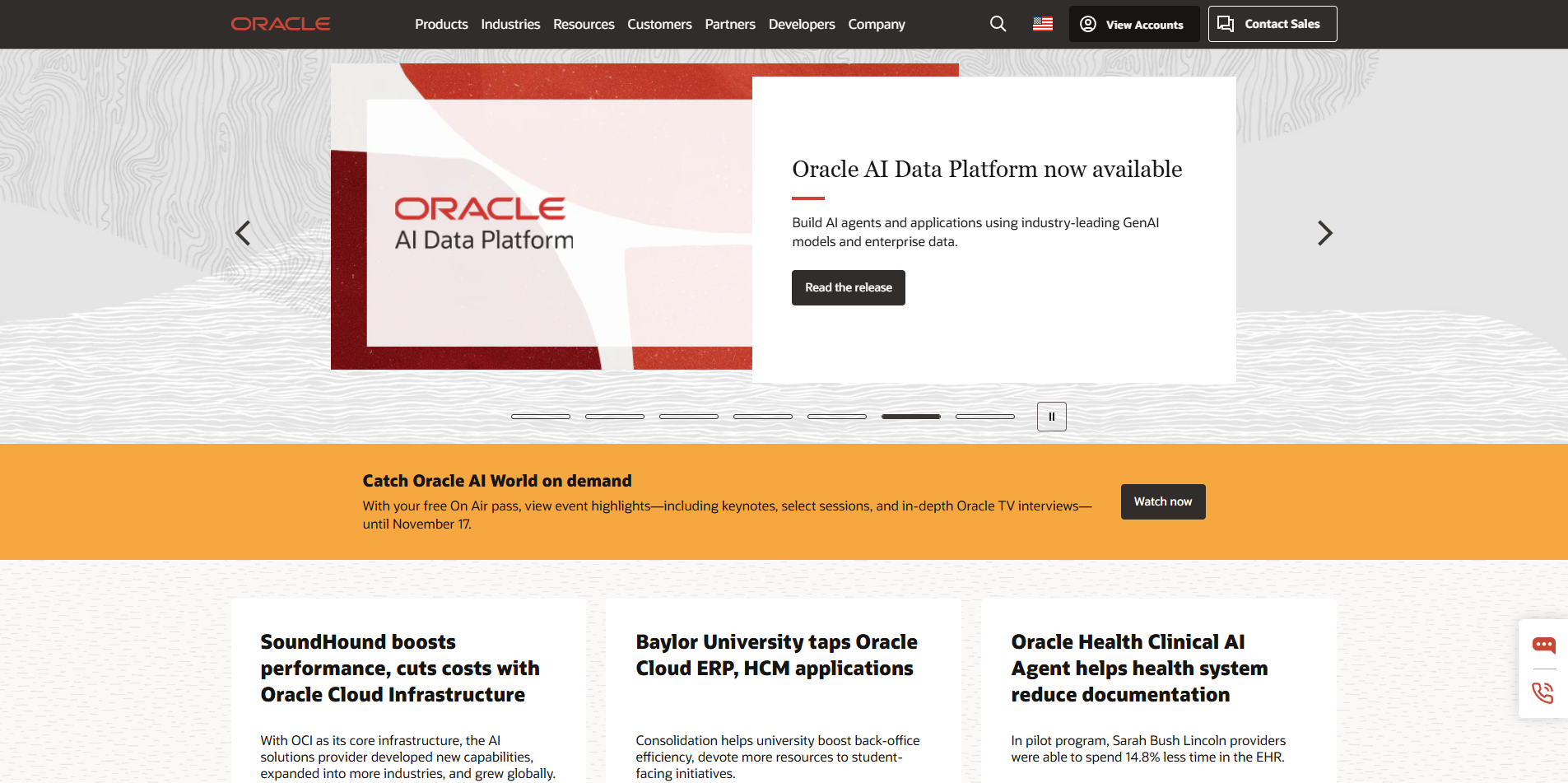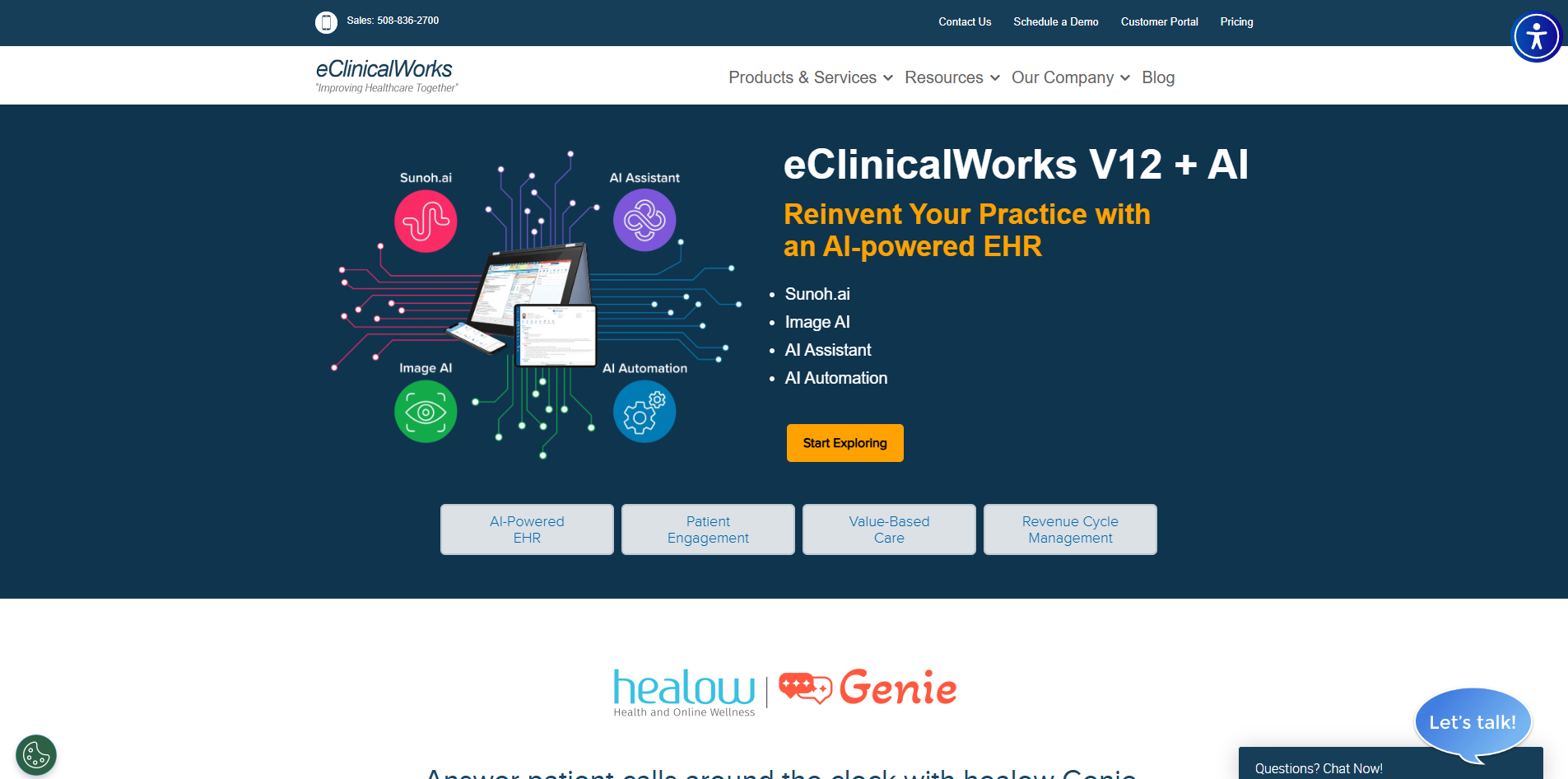
Healthcare Practice Management
10 mins
Ambulatory EMR Systems: Importance, Key Features & Top Vendors in 2026
Summary
Your Competitors Are Embracing AI – Are You Falling Behind?
Ambulatory EMR systems (or EHR systems) have become a cornerstone of modern outpatient care, helping clinics and specialty practices manage patient records with greater accuracy and efficiency.
These electronic medical (or health) record solutions streamline workflows, reduce administrative burdens, and improve the overall patient experience by connecting providers and patients through smarter technology.
With a growing number of vendors and features available, choosing the right system can feel overwhelming for healthcare organizations of all sizes.
In this article, we’ll explore what ambulatory EMR systems are, their key benefits and features, the top vendors in 2026, and how to select the best fit for your practice.
TL;DR
- Ambulatory EMR systems are specialized electronic health record solutions for outpatient and clinic-based care.
- Benefits include streamlined workflows, improved care coordination, better regulatory compliance, and enhanced patient engagement.
- Choosing the right system requires assessing pain points, integration needs, scalability, and vendor support.
What Are Ambulatory EMR Systems?
What is ambulatory EHR (or EMR)? These systems are a type of electronic health record software designed specifically for outpatient care, where patients don’t require overnight hospital stays.
Unlike inpatient systems, which handle complex hospital workflows, ambulatory systems focus on managing patient visits in clinics, practices, and specialty centers.
These systems help physicians, nurses, and staff capture patient data, track medical histories, manage prescriptions, and streamline scheduling; all while supporting regulatory compliance.
Many ambulatory EMR vendors now integrate advanced features like telehealth and mobile access to enhance efficiency and patient satisfaction.
Benefits Of Using The Right Ambulatory Electronic Health Records
Choosing the right ambulatory electronic health records for your healthcare organization brings numerous benefits. Let’s take a closer look at these.
1. Streamlined Outpatient Care
Ambulatory EMR systems eliminate time-consuming manual tasks by automating appointment scheduling, documentation, and coding processes.
Instead of juggling paper charts or navigating multiple disconnected systems, providers can access patient information instantly in one centralized platform.
This not only reduces administrative burden but also minimizes errors in record-keeping, leading to smoother patient visits and faster turnaround times.
By streamlining these workflows, clinicians can dedicate more time to direct patient care, ultimately improving both productivity and quality of service.
2. Enhanced Care Coordination
One of the biggest advantages of modern ambulatory systems is their ability to facilitate seamless communication between providers, specialists, and departments.
With secure, interoperable platforms, patient records can be shared in real time across different facilities, reducing duplication of tests and preventing gaps in care.
For example, a primary care physician can instantly share records with a cardiologist or lab, ensuring everyone involved in a patient’s care has the most up-to-date information.
This connectivity fosters continuity of care, strengthens collaborative decision-making, and helps deliver more personalized treatment plans.
3. Regulatory Compliance & Reporting
Healthcare organizations must constantly adapt to evolving regulations such as HIPAA, MACRA, and MIPS. Ambulatory EMR systems simplify compliance by offering built-in templates, automated alerts, and reporting dashboards that track key performance measures.
Instead of scrambling to compile data manually for audits or incentive programs, practices can generate reports in just a few clicks. This not only reduces compliance risk but also positions practices to benefit from value-based care incentives and government reimbursement programs.
Strong reporting functionality also provides administrators with insights to optimize workflows and meet both federal and state requirements with confidence.
4. Improved Patient Engagement
Today’s patients expect transparency and convenience in managing their healthcare. Ambulatory EMR systems deliver this through secure patient portals that provide real-time access to lab results, appointment scheduling, prescription refills, and direct messaging with providers.
This fosters a sense of empowerment, as patients can take an active role in their care rather than passively waiting for updates. Moreover, features like mobile apps and automated reminders help patients stay on track with medications and follow-up visits.
Engaged patients are more likely to adhere to treatment plans, leading to better outcomes and stronger patient-provider relationships.
5. Financial & Operational Efficiency
Beyond clinical improvements, ambulatory EMR systems play a critical role in strengthening the financial health of a practice. Integrated billing and coding features reduce errors in claim submissions, cutting down on costly denials and accelerating reimbursement cycles.
Many platforms also provide real-time financial dashboards, giving administrators visibility into cash flow and revenue performance.
By automating revenue cycle management, practices can minimize leakage, maximize reimbursement opportunities, and improve long-term sustainability.
This financial efficiency allows practices to reinvest in technology, staff, and patient care initiatives, creating a cycle of continuous improvement.
Main Features Of Ambulatory EHR Systems
The advantages of ambulatory EHR systems are undeniable. Let’s take a look at their main features in closer detail.
1. Customizable Clinical Documentation
Modern ambulatory EMR systems provide flexible templates that can be tailored to specific specialties and workflows, enabling physicians to capture patient information accurately without slowing down consultations.
This reduces repetitive data entry while maintaining compliance with clinical standards. For example, a cardiology practice can configure templates for cardiac exams, while a dermatology clinic can customize documentation for skin assessments.
Over time, these adaptable tools not only improve efficiency but also contribute to higher-quality records that support better patient outcomes.
2. E-prescribing (eRx)
E-prescribing functionality allows providers to send prescriptions electronically to pharmacies, reducing errors caused by handwritten notes and miscommunication.
Many platforms also include medication history checks, allergy alerts, and drug interaction warnings, which greatly enhance patient safety. In addition, patients benefit from faster fulfillment times and fewer hassles at the pharmacy.
For practices, eRx capabilities save time, reduce callbacks from pharmacists, and contribute to a more streamlined patient experience.
3. Integrated Billing
One of the most valuable features of ambulatory EMR systems is integrated billing, which connects clinical documentation directly to financial workflows.
This reduces coding errors, eliminates duplicate data entry, and ensures claims are submitted with complete and accurate information.
Many systems also include automated coding suggestions and eligibility verification, which speed up reimbursement cycles.
By aligning clinical and financial operations, practices can improve revenue capture and free staff to focus on patient-facing tasks rather than administrative corrections.
4. Telehealth Support
The rise of virtual care has made telehealth support a must-have in ambulatory EHR systems. Integrated telehealth modules allow providers to conduct secure video visits, share records during sessions, and document encounters directly within the same system.
This eliminates the need for third-party platforms and ensures continuity of care for patients who can’t attend in person.
Telehealth features also expand a clinic’s reach, enabling providers to serve rural populations, high-risk patients, or those with limited mobility, all while maintaining HIPAA compliance.
5. Patient Portals
Patient portals are central to improving communication and transparency between providers and patients. Beyond simply viewing lab results, today’s portals allow patients to request prescription refills, send secure messages, complete intake forms online, and even pay bills digitally.
These self-service capabilities save staff time, reduce phone traffic, and give patients greater control over their healthcare journey. In a competitive healthcare environment, offering a robust patient portal also helps practices attract and retain patients by meeting modern expectations for digital access.
6. Analytics & Reporting
Data-driven decision-making is critical for outpatient practices, and ambulatory EMR systems now provide built-in analytics tools to support this.
Reporting dashboards track everything from clinical outcomes to revenue cycle performance, allowing administrators to identify bottlenecks and optimize operations.
For example, a practice can generate reports on appointment no-show rates, identify underperforming service lines, or monitor compliance metrics for government programs.
With actionable insights readily available, providers can make informed choices that improve both patient care and business performance.
Top Ambulatory EHR Vendors In 2026
There are five ambulatory EHR vendors that stand out for 2026. Below, we explore these platforms and their stand-out features.
1. EpicCare Ambulatory

Top features: EpicCare Ambulatory remains the gold standard for enterprise-level EHR functionality. It offers unmatched scalability, multi-specialty support, and robust interoperability that connects seamlessly across Epic’s network and external systems. Its advanced reporting, data visualization, and customizable workflows make it a comprehensive solution for data-driven healthcare organizations.
For whom: Ideal for large healthcare systems, multi-specialty practices, and organizations prioritizing integrated care networks and long-term scalability.
Pros & cons: The biggest advantage is Epic’s breadth and depth—it can handle virtually any ambulatory workflow. However, its implementation is resource-intensive, with higher costs and longer deployment times compared to smaller vendors.
Pricing: Typically enterprise-level pricing; implementation and licensing are customized based on organization size and configuration, often starting in the high six-figure range for large practices.
2. Oracle Cerner Ambulatory

Top features: Cerner Ambulatory stands out for its advanced clinical documentation, population health management, and analytics tools. It empowers providers to identify at-risk patients, monitor outcomes, and drive value-based care initiatives through rich dashboards and reporting.
For whom: Best for large and mid-sized organizations focused on data insights, interoperability with hospital systems, and managing large patient populations.
Pros & cons: A major strength is its robust analytics and hospital-grade interoperability. On the downside, customization and user experience can be complex, requiring dedicated IT and training resources.
Pricing: Pricing is quote-based; Cerner’s solutions are typically positioned at the mid-to-high end of the market depending on scale and modules selected.
3. NextGen Healthcare

Top features: NextGen offers specialty-specific workflows, customizable templates, and a unified platform that integrates clinical operations with billing and revenue cycle management. It also includes patient engagement and population health tools to support coordinated, efficient care.
For whom: Best suited for mid-sized and specialty practices seeking customizable, end-to-end functionality without the overhead of enterprise-scale systems.
Pros & cons: NextGen’s biggest strength is its flexibility for specialty practices. However, its extensive configurability can make setup time-consuming, and some users report variability in customer support.
Pricing: Subscription-based pricing typically starts at around $400–$600 per provider per month, depending on features and integrations.
4. eClinicalWorks

Top features: eClinicalWorks delivers a comprehensive, affordable, and user-friendly EHR platform that includes telehealth, patient engagement, and population health tools. Its cloud-based and mobile access options make it a flexible choice for smaller practices.
For whom: Designed for small to mid-sized practices looking for a cost-effective, all-in-one solution that doesn’t compromise on functionality.
Pros & cons: Its greatest strength is affordability combined with feature richness. However, while easy to use, it lacks the deep customization and scalability of larger EHR vendors.
Pricing: Cloud-based plans start at roughly $449 per provider per month, with optional modules available for telehealth and additional analytics.
5. Athenahealth

Top features: Athenahealth’s cloud-based EHR stands out for its seamless revenue cycle management, patient engagement, and continuous software updates. The platform’s intuitive workflows reduce training time and enhance operational efficiency.
For whom: A great fit for growing practices that prioritize financial performance, compliance, and patient engagement without heavy IT burdens.
Pros & cons: The platform’s ease of use and scalability are key advantages. However, customization options can be more limited compared to on-premise EHRs, and pricing can increase with advanced modules.
Pricing: Generally starts at 4–7% of monthly collections under Athenahealth’s revenue-share model, which includes EHR, billing, and support services.
How To Choose The Right Ambulatory Medical Record System
Selecting the right amulatory EMR system for your organization may seem challenging at first. Bear the following in mind when choosing the optimal platform for your needs.
1. Identify Pain Points
Before investing in an ambulatory EMR system, practices should conduct a thorough assessment of their current workflows to uncover bottlenecks and inefficiencies.
Common pain points include lengthy charting processes, frequent billing errors, scheduling conflicts, or challenges with patient follow-up. Identifying these issues upfront ensures that the chosen system directly addresses the practice’s unique needs, rather than adding unnecessary complexity.
This step helps avoid costly mismatches and sets the foundation for a smoother implementation.
2. Set Integration Priorities
Ambulatory EMR systems rarely operate in isolation; they must connect seamlessly with other tools such as lab systems, imaging software, billing platforms, and patient engagement apps.
Prioritizing which integrations matter most allows practices to evaluate vendors effectively and ensure interoperability. For example, a practice heavily reliant on diagnostic testing will need strong lab connectivity, while another may prioritize revenue cycle tools.
Establishing these priorities early prevents future headaches and supports a more unified, efficient ecosystem.
3. Assess Scalability
A system that meets today’s needs may quickly fall short as the practice grows or adopts new service lines. Scalability should be a core consideration, ensuring the EMR can handle increased patient volumes, additional specialties, or expanded telehealth offerings without disrupting workflows.
Practices should also consider vendor roadmaps and whether the platform can adapt to future regulatory changes and evolving technologies. Choosing a scalable system safeguards long-term value and reduces the need for disruptive system migrations later.
4. Evaluate Vendor Support
Even the most advanced EMR is only as effective as the support behind it. Strong vendor support includes comprehensive training, guided implementation, and responsive technical assistance.
Practices should look for vendors that provide ongoing education, user communities, and 24/7 support channels to address issues quickly. A vendor’s reputation for customer service can make the difference between a smooth rollout and years of frustration.
This factor is especially important for smaller practices with limited in-house IT resources.
5. Consider Cost Vs. ROI
While cost is always a critical factor, practices should view pricing through the lens of return on investment rather than just upfront expenses.
A system that appears more expensive may actually save money in the long run through improved billing accuracy, faster reimbursements, and reduced administrative overhead.
Practices should also account for hidden costs such as training, hardware upgrades, and ongoing licensing fees.
By balancing affordability with long-term value, organizations can select an EMR that strengthens both financial performance and patient outcomes.
Key Takeaways
Ambulatory EMR systems are vital for outpatient and specialty practices, enabling streamlined care, compliance, and patient engagement.
Features like e-prescribing, telehealth, and integrated billing improve both clinical and financial workflows.
Careful evaluation of needs, scalability, and vendor support ensures successful implementation.
FAQs
Who Needs An Ambulatory EHR System?
Any outpatient practice, including primary care clinics, specialty providers, and urgent care centers, benefits from an ambulatory EHR system.
It helps manage patient visits, documentation, billing, and reporting efficiently.
Ambulatory EHR Vs Inpatient EHR: What’s The Difference?
Ambulatory EHRs are designed for outpatient settings with short visits, while inpatient EHRs handle complex workflows like admissions, discharge planning, and bed management.
Ambulatory Vs Acute Care EHRs: What’s The Difference?
Ambulatory EHRs focus on scheduled visits and ongoing care management, whereas acute care systems prioritize high-intensity, hospital-based treatment and emergency workflows.
Can You Create Your Own Ambulatory EMR?
Although technically possible, building a compliant, secure, and interoperable EMR system requires significant resources.
Most clinics opt for established ambulatory EMR vendors for reliability and regulatory compliance.
How Much Does An Ambulatory EHR Cost In 2026?
Costs vary widely. Small practices may pay $200–$500 per provider per month, while enterprise solutions can exceed $1,000 per provider per month, plus setup and training fees.
How Long Does The Implementation Of An Ambulatory EMR System Usually Take?
Depending on practice size, implementation may take 3–6 months, including training, data migration, and workflow adjustments.
Can You Integrate Your Billing Software With An Ambulatory EHR?
Yes, most modern systems support billing integration, reducing errors and speeding up reimbursement cycles.
How Big Is The Ambulatory EHR Market?
The global ambulatory EHR market continues to grow, driven by regulatory requirements, telehealth adoption, and the demand for integrated care. Estimates put its value in the tens of billions of dollars by 2026.
Unlock 300+ integrations with no hidden fees, bespoke rewards, and dedicated support
Related Articles
Related Articles















